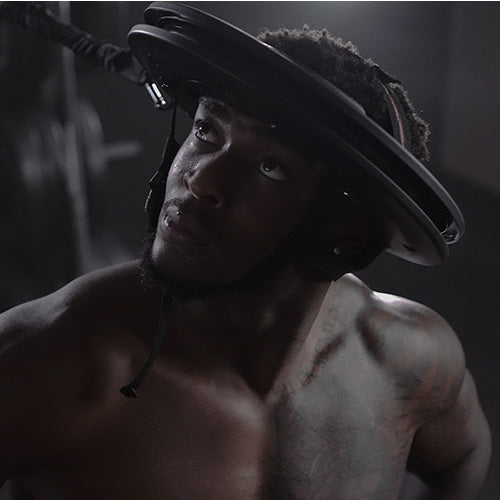Introduction
Hey there! Ever wake up with a stiff neck or feel that nagging tension after a long workday? You're not alone. Many of us, especially men between the ages of 30 and 50, deal with neck pain and stiffness. The good news is that neck rolls, a straightforward exercise, can work wonders in easing discomfort and improving mobility. In this article, we’ll dive into the purpose of neck rolls, how to perform them correctly, and why the Iron Neck is the best device to supercharge your neck strength and recovery.
Why Neck Rolls?
Neck rolls are a hidden gem in the world of fitness and rehabilitation. Here’s why they’re worth your time:
- Relieve Tension: Perfect for those who sit at a desk all day, neck rolls help to release built-up tension and stress.
- Improve Flexibility: Regularly practicing neck rolls enhances the range of motion in your neck.
- Prevent Injuries: By keeping your neck muscles flexible and strong, you reduce the risk of injuries.
- Ease Pain: If you're dealing with chronic neck pain, neck rolls can provide much-needed relief.
How to Perform Neck Rolls
Alright, let’s get down to the nitty-gritty of performing neck rolls. Follow these steps to ensure you’re doing them correctly:
- Start Position: Sit or stand comfortably with your back straight and shoulders relaxed.
- Chin to Chest: Slowly lower your chin towards your chest, feeling the stretch along the back of your neck.
- Roll to the Side: Gently roll your head to the right, bringing your ear towards your shoulder. Hold for a few seconds.
- Full Circle: Continue rolling your head back, then to the left, and finally bring your chin back to your chest.
- Repeat: Perform 5-10 rolls in each direction, ensuring smooth and controlled movements.
Tips for Effective Neck Rolls
- Move Slowly: Avoid rushing through the movements. Slow and steady wins the race.
- Breathe: Don’t forget to breathe deeply and evenly throughout the exercise.
- Stay Relaxed: Keep your shoulders relaxed to maximize the stretch.
- Listen to Your Body: If you feel any sharp pain, stop immediately and consult a professional.
Purpose of Neck Roll Exercise: Benefits of the Movement
The neck roll offers a multitude of benefits when executed correctly. Let’s unpack why has it been a staple in many exercise routines for years.
Strengthening the Neck Muscles
The neck houses several muscles, including the sternocleidomastoid, trapezius, and the smaller stabilizing side of neck muscles, which are often overlooked in regular fitness regimens.
Consistent neck rolls challenge these muscles and fortify them over time. Strong neck muscles not only provide better support to the head but also protect the spine, potentially reducing the risk of injuries like whiplash.
Improving Flexibility and Range of Motion
A stiff neck can limit one's ability to look over their shoulder, tilt the head, or even nod. The good news is you can promote improved neck flexibility by gently stretching and compressing the neck muscles through the neck roll exercise.
This increased suppleness can translate to a greater range of motion over time, making everyday tasks smoother and more comfortable.
Potential Pain Relief and Relaxation Benefits
The neck is a hotspot for tension in many individuals, especially if you're spending hours hunched over a computer or looking down at your phone. This can lead to the dreaded tech neck - in other words, forward neck posture.
The gentle, rhythmic motion of the neck roll can act as a massage by increasing blood flow to the area. This helps flush out toxins and alleviate muscle knots. This not only can provide pain relief but also promotes relaxation, a brief respite in our fast-paced lives.
You can learn more about this in our guides on how to relax tight neck muscles, how to fix bad neck posture, and how to improve neck posture. For now, though, let’s get into how to perform neck roll exercise step by step so you can reap these benefits firsthand.
Real-Life Stories
Let’s hear it from some folks who’ve experienced the benefits of neck rolls firsthand.
John’s Story: John, a 42-year-old office worker, used to suffer from chronic neck pain due to long hours at his desk. After incorporating neck rolls into his daily routine, he noticed significant improvements in his mobility and a reduction in pain. "I used to dread waking up with a stiff neck," John says. "But now, neck rolls have become my go-to exercise for relief."
Mike’s Journey: Mike, a 38-year-old fitness enthusiast, initially overlooked neck exercises in his workout regimen. After a minor neck injury, he started doing neck rolls to aid his recovery. "I was surprised at how effective such a simple exercise could be," Mike shares. "It’s now a staple in my warm-up routine."
Why Iron Neck is the Ultimate Tool
If you’re serious about neck strength and recovery, the Iron Neck is a game-changer. Here’s why:
- 360° Isometric Training: Unlike traditional neck rolls, the Iron Neck allows for full 360-degree movement, providing comprehensive neck training.
- AirFit™ Technology: Ensures a comfortable and customized fit for every user.
- Friction-Free Sliders: Allows for smooth and controlled movements, reducing the risk of strain.
- Rotational Resistance: Available in the Iron Neck 3.0 Pro model, it adds an extra layer of resistance, enhancing strength and flexibility.
Benefits of Using Iron Neck
- Pain Relief: 96% of users report reduced pain.
- Improved Mobility: Users experience better range of motion and flexibility.
- Enhanced Strength: Helps build strong neck muscles, reducing the risk of injuries.
- Versatile Use: Suitable for home and gym setups, making it easy to incorporate into your routine.
FAQs
Q: How often should I do neck rolls? A: Aim to perform neck rolls 2-3 times a day, especially if you spend long hours sitting or have neck pain.
Q: Can neck rolls help with headaches? A: Yes, neck rolls can help alleviate tension headaches by reducing muscle tension in the neck and shoulders.
Q: Is it normal to feel dizzy during neck rolls? A: Some people may feel lightheaded during neck rolls. If this happens, stop immediately and consult a healthcare professional.
Q: Can I use the Iron Neck if I have a neck injury? A: It’s best to consult with a medical professional before using the Iron Neck if you have a neck injury.
Q: How long does it take to see results with the Iron Neck? A: Many users report noticeable improvements within a few weeks of consistent use.
Conclusion
Neck rolls are a fantastic exercise to relieve tension, improve flexibility, and reduce pain. By incorporating them into your daily routine, you can enjoy a more mobile and pain-free neck. And if you’re looking to take your neck strength and recovery to the next level, the Iron Neck is your ultimate companion. So, why wait? Give neck rolls a try and experience the benefits for yourself!



